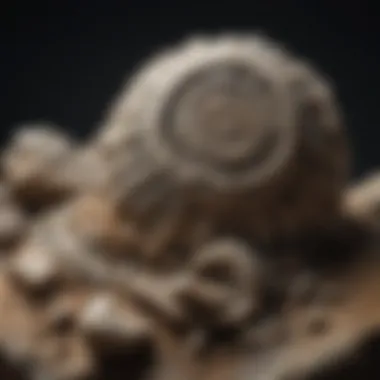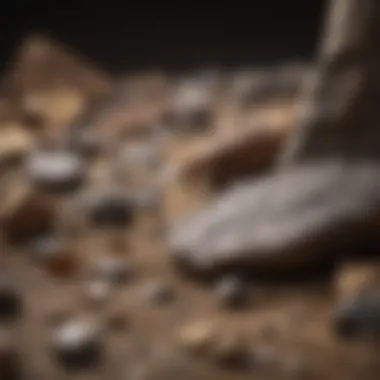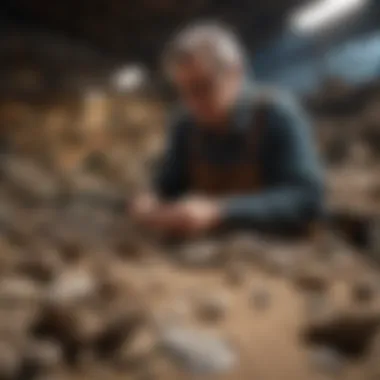Understanding Fossil Prices: A Comprehensive Analysis


Intro
The world of fossils is as intricate as the earth from which they come. Fossils serve as a window into ancient life, enabling collectors to bridge the past with the present. Yet, the realm of fossil prices often poses challenges. Understanding what influences these prices helps collectors make informed choices. This article sets the stage for a detailed exploration of fossil pricing, aiming to dissect the various elements that affect valuation and market dynamics.
Topic Overview
Definition of Fossils
Fossils are the preserved remains or traces of once-living organisms. They typically find themselves embedded in sedimentary rock, providing valuable insights into the biological and geological history of our planet. Fossils can take many forms—bones, imprints, and even amber that encapsulates organisms. Collectors find fossils not only aesthetically pleasing but also significant due to their scientific importance.
Brief History and Significance
The fascination with fossils dates back centuries. Early paleontologists, such as Gideon Mantell and Mary Anning, made crucial contributions to our understanding of extinct species. Fossils have since evolved into a vital component of both academic research and private collections. The significance of fossils extends beyond mere collectibles; they serve as paramount evidence for scientific inquiry, helping us comprehend the evolution and extinction of species.
Identification and Classification
How to Categorize Items
Understanding how to classify fossils aids in valuation. Fossils can be divided into several categories:
- Trace Fossils: Indirect evidence of life, such as footprints and burrows.
- Body Fossils: Actual remains, like bones or shells.
- Permineralized Fossils: Minerals fill in the spaces within organic material, preserving the structure.
- Coprolites: Fossilized dung, providing insights into the diets of ancient organisms.
Each category carries its own market characteristics, which can affect pricing.
Tips for Identifying Key Features
Identifying distinguishing features is crucial for valuation. Here are some tips to help:
- Examine the material: Is it rock, mineral, or organic substance?
- Look at the size: Larger, well-preserved fossils often attract higher prices.
- Assess the completeness: A fully intact specimen usually holds more value than a fragmented one.
- Investigate the provenance: Knowing the origin of a fossil can increase its desirability.
"Understanding key features of fossils can significantly enhance the collecting experience."
Collectors should consider these factors when evaluating potential purchases, particularly at auctions or trade shows.
In summary, grasping the essential elements of fossil prices equips collectors with the knowledge necessary to navigate this fascinating pursuit. The complexities surrounding fossil valuation are significant and multifaceted, making informed decisions critical for any serious collector.
The Basics of Fossil Pricing
Fossils hold significant value in both scientific and commercial realms. Understanding fossil pricing is crucial for collectors, investors, and enthusiasts alike. The reasons for this importance range from the desire to accurately assess the investment value of a fossil to the necessity of distinguishing between genuine and replica specimens.
Fossil pricing is not merely about monetary valuation; it also reflects the underlying historical and scientific significance of these specimens. As such, the factors that determine fossil prices can be intricate, making this field both complex and fascinating.
Definition and Importance of Fossil Valuation
Fossil valuation refers to the process of determining the worth of fossil specimens based on various criteria. These criteria can include rarity, historical significance, and the condition of preservation. Proper valuation is vital for making informed decisions during a purchase or sale.
Understanding fossil valuation can prevent collectors from overpaying or underselling their specimens. Additionally, accurate valuation assists in establishing a market price that reflects the quality and uniqueness of the fossil. Collectors who recognize the importance of valuation put themselves in a stronger position to develop a quality collection that can appreciate over time.
Historical Context of Fossil Prices
Examining the historical context of fossil prices sheds light on their evolution over time. Fossil prices have fluctuated significantly, influenced by several factors, including archaeological discoveries, market demand, and scientific advancements.
In the 19th century, for example, the rise of paleontology as a science led to increased interest in fossils. This era saw a spike in prices, particularly for dinosaurs and large specimen finds.
In recent years, social media and online marketplaces have further transformed how fossils are bought and sold. Enhanced accessibility has resulted in a broader audience for fossil collecting, driving prices up for some rare specimens. Nonetheless, understanding this context helps buyers recognize value trends, enabling them to make smarter investment choices.
Factors Influencing Fossil Prices


Understanding fossil prices involves recognizing various elements that impact valuation in this unique market. Factors such as rarity, condition, scientific significance, and market demand shape how fossils are priced. Each factor interplays with others, affecting both collectors and investors in their decision-making processes. As fossil collecting grows in popularity, acknowledging these influences becomes crucial for anyone looking to acquire valuable specimens.
Rarity and Availability
Rarity is a central topic in fossil pricing. Fossils that are less common naturally command higher prices. A species that has not been discovered in large quantities, like certain dinosaur bones, can greatly increase the value of a find. Availability also relates to geographical locations where fossils can be found. For example, fossils from specific eras, such as the Cretaceous period, may be hard to come by. Additionally, the demand for certain fossils can shift based on recent scientific discoveries or popular media. Oftentimes, availability directly correlates with price.
Condition and Preservation
The condition of a fossil is paramount when determining its worth. Fossils that are well-preserved exhibit less wear and maintain their structural integrity. For instance, an ammonite with missing sections or damage will be significantly less valuable compared to one that is whole and intact. Preservation techniques play a vital role here as well. Fossils that have been exposed to elements or mishandled can deteriorate over time, reducing their marketability and price. Collectors should seek fossils that show excellent preservation and minimal restoration work, as these factors will enhance future resale potential.
Scientific Significance
Scientific significance adds another layer to the valuation of fossils. Fossils can tell us about Earth's history, evolutionary milestones, and climate changes. Fossils that contribute to pivotal discoveries are often in higher demand. A rare species that helps fill gaps in evolutionary history, for example, can be considered highly valuable. In academic and research settings, fossils with outstanding scientific significance may be priced higher due to their contributions to science. Additionally, the pedigree of a fossil, or its documentation of previous ownership by a notable collector or institution, can further elevate its status and price.
Market Demand and Trends
Market demand fluctuates based on various trends. Popular culture, paleontological research developments, or shifts in collector interests heavily influence what types of fossils are sought after. For instance, recent events, such as high-profile fossil sales at auctions or notable discoveries in media, can spark a surge in interest for specific fossils or periods. Not only do collectors need to stay informed on these trends, but they must also recognize how these fluctuations can lead to rapid changes in pricing. Furthermore, economic conditions impact disposable income, which can subsequently affect the market for fossils.
Understanding these factors helps collectors navigate the complexities of fossil pricing effectively.
Types of Fossils and Their Price Ranges
Understanding the various types of fossils and their price ranges is crucial for both collectors and investors. Fossils can vary vastly in terms of rarity, condition, and scientific significance. This section will cover common, rare, and exceptional specimens, providing insight into their value, market demand, and factors influencing their prices.
Common Fossils
Ammonites
Ammonites are highly sought after due to their intricate and often beautifully preserved shells. They represent an extinct group of marine mollusks that thrived throughout the Mesozoic era. Their unique spiral shape makes them visually appealing to collectors. Ammonites can be found in various sizes, which contributes to their diverse price range. The demand for ammonite fossils remains strong due to their aesthetic value. However, it is essential to understand that many ammonite specimens are widely available, which can affect pricing stability in the market.
Fossilized Wood
Fossilized wood is another popular choice among collectors. This type of fossil occurs when plant material is partially replaced by minerals, often creating strikingly colorful pieces. Fossilized wood is valued not only for its beauty but also for its geological and botanical significance. Although prices can vary based on quality and age, fossilized wood tends to attract a stable interest from both museum curators and private collectors. However, finding genuinely unique pieces may require patience and research.
Shark Teeth
Shark teeth fossils are commonly found and are particularly appealing to collectors. Their history stretches back millions of years, representing some of the largest and most formidable creatures of the ocean. Shark teeth come in numerous shapes and sizes, with some rarer types fetching higher prices. Their popularity stems not only from their historical significance but also from their accessibility. While many collectors enjoy hunting for these fossils, prices can fluctuate based on demand and condition.
Rare Fossils
Dinosaur Bones
Dinosaur bones are perhaps the most famous category of fossils. They captivate both the scientific community and the general public. The size and completeness of these fossils significantly affect their value. Larger and more complete specimens can command exceptionally high prices at auctions and private sales. However, the rarity of genuine dinosaur bones means that aspiring collectors may face high barriers to entry. The investment potential, though significant, comes with inherent risks due to market volatility.
Marine Reptiles
Marine reptiles, like ichthyosaurs and plesiosaurs, represent another fascinating category of rare fossils. These creatures lived in ancient oceans and are often found in remarkably preserved states. The high level of interest among paleontologists and collectors creates a healthy market for marine reptile fossils. While they are relatively rare, the excitement around these fossils can drive prices upward. Thus, collectors should be aware of provenance and authenticity when investing.
Early Mammals
Fossils of early mammals are also of great significance. They provide insights into the evolution and adaptation of mammals after the dinosaurs. Collectible examples, especially of unique species, can reach substantial prices, driven by both their scientific value and market demand. Nevertheless, early mammal fossils are less common than other types, making them a more exclusive investment for serious collectors.
Exceptional Specimens
Amber with Inclusions
Amber is a unique fossil that preserves ancient organic materials, creating captivating specimens. Amber with inclusions, such as insects or plant material, draws significant interest from both collectors and scientists. The rarity of such finds directly impacts their value. Collectors prize these specimens not only for their beauty but also for the information they can yield about past ecosystems. However, potential buyers should be cautious of replicas and ensure authenticity in their pursuits.


Multiple Specimen Finds
Sometimes, collectors encounter multiple specimen finds, where several fossils are discovered in close proximity. This can include groups of the same species or various types within a similar ecological microenvironment. These finds can enhance educational value, making them attractive for museums. However, securing multiple specimens does not always guarantee higher resale values. The context and quality of the specimens play a vital role in pricing.
Fossilized Eggs
Fossilized eggs are rare and potentially valuable fossils. They can provide insights into reproductive behaviors of ancient species. The condition and type of egg significantly contribute to their market value. Certain eggs can become highly sought-after items in collections, owing to their uniqueness. However, they often require careful handling and display considerations to maintain their integrity, which may deter some collectors.
Collectors should always invest in knowledge as much as the fossils themselves; understanding the nuances of fossil types ensures better investment decisions.
Market Dynamics of Fossil Sales
Fossil sales operate within a unique market that is influenced by a variety of dynamics. Understanding these dynamics is crucial for collectors, investors, and anyone interested in fossil acquisition. The way fossils are bought and sold can affect their prices and overall value. Different avenues exist for acquiring fossils, each with its own characteristics that can shape the transaction process.
Private Sales vs. Auctions
Private sales and auctions present distinct approaches to buying and trading fossils. In private sales, collectors engage directly with sellers, often allowing for negotiation on price. This method can foster a more personal transaction, favorable for both parties. This setting may also lead to less competitive pressure, giving buyers more time to consider their purchase. However, price transparency can sometimes be an issue. Without a plethora of bidders, determining a fair price relies heavily on the credibility of the seller and the buyer's research.
Conversely, auctions present a competitive landscape where multiple buyers can drive prices up. Auctions can be held in person or online and often feature expert assessments before the bidding begins. This dynamic can create an environment of urgency where buyers feel compelled to act quickly. However, the risk of overbidding often lurks in such scenarios, as emotions may cloud judgments. Additionally, auction fees may apply, influencing the overall cost of acquisition.
Online Marketplaces
The rise of online marketplaces has revolutionized fossil trading. Platforms like eBay and specialized fossil sale websites have made fossil collecting more accessible than ever. These online spaces offer a vast array of fossils, from common finds to rare specimens, catering to various levels of collectors.
Shopping online provides convenience and the ability to compare prices across multiple listings instantly. Detailed photographs and seller ratings also help collectors assess the quality and authenticity of the fossils. However, buyers must exercise caution. Without the opportunity to physically inspect an item, there is a risk of misrepresentation. Potential buyers should perform due diligence, checking seller credentials and reviewing previous customer feedback.
Institutional Auctions and Expositions
Institutional auctions and expositions provide another vital platform for fossil sales. Major institutions like the American Museum of Natural History periodically auction off rare specimens. These events offer a unique blend of prestige and access to exceptional fossils, often attracting serious collectors and investors.
The credibility of the institutions hosting these auctions often adds significant value to the fossils being sold. Pieces sold in these venues frequently come with a reputable provenance, which can enhance their appeal.
Nevertheless, the competitive nature of institutional auctions often means higher starting bids due to the rarity of the items. Participation may also require advance registration and adherence to specific auction procedures. Overall, these auctions and exhibitions serve as a nexus for acquiring exceptional fossils and connecting with other enthusiasts and professionals in the field.
Understanding the dynamics behind fossil sales helps collectors and investors make informed decisions, ensuring that they navigate the complexities of the fossil market effectively.
Evaluating Fossil Prices
Evaluating fossil prices is essential for both collectors and investors. This process helps to establish the worth of a fossil in a market that can be quite dynamic. Understanding this evaluation can assist buyers and sellers in making informed decisions about their transactions. When evaluating a fossil, several techniques can be employed to determine its value accurately. This assessment not only impacts the monetary aspect but also reflects the fossil's significance in scientific, educational, and cultural contexts.
Appraisal Techniques
Expert Evaluations
Expert evaluations are a crucial part of determining fossil prices. These evaluations involve professionals analyzing the fossil's characteristics. Experts often have years of experience, which adds credibility to the evaluation process. This method is popular because it provides an objective perspective. The primary characteristic of expert evaluations is their thoroughness. Experts examine various factors such as geological context, fossil morphology, and historical significance.
The unique feature of this approach is its reliance on proven knowledge and experience. One advantage is that it can provide a clear picture of a fossil’s worth. However, the downside can be the cost of hiring an expert, which may not always fit within a collector's budget.
Comparative Analysis
Comparative analysis involves studying similar fossils to establish value. This technique compares the fossil in question with others of its kind that have sold in recent times. A key feature of this method is its straightforwardness. It allows collectors to see how their fossils measure up against comparable specimens.
It is a beneficial approach because it uses real-world data to inform pricing. The unique aspect of comparative analysis is its reliance on market trends and sales history. This method can provide beneficial insights, but a disadvantage is that it can sometimes overlook specific nuances of an individual specimen.
Market Research
Market research is another critical aspect when evaluating fossil prices. This involves gathering data on current market trends, buyer interests, and sales patterns. One of the key characteristics of market research is its comprehensive nature. It gives collectors an overview of the broader market landscape.


The unique feature of market research is its ability to highlight trends and shifts in buyer behavior. This method is popular because it offers collectors a strategic advantage. However, the downside is that trends can change rapidly, making it challenging to forecast future value accurately.
The Role of Certifications
In the realm of fossil collecting, certifications serve an indispensable role in verification and valuation. Certified fossils often command higher prices in the market. These certifications provide assurance to buyers about the fossil’s authenticity and preservation status. Institutions or experts that issue these certifications play a critical role in maintaining the integrity of fossil transactions. The presence of a certification can significantly enhance a fossil's market appeal, further shaping its price.
"A certified fossil is not just a piece of history; it’s an assurance of its authenticity and value."
Assessing fossil prices through these various techniques allows collectors to navigate the market effectively. Understanding expert evaluations, comparative analysis, and market research each sheds light on different aspects of valuation, while certifications support the trustworthiness of transactions. Together, they form a robust framework for evaluating fossils effectively.
Trends Affecting Fossil Prices
Understanding the trends affecting fossil prices is essential for collectors and investors. As the market fluctuates, various factors can significantly influence the value of fossils. By examining economic factors and cultural impacts, one can grasp how these elements shape the fossil market. Such insights will help collectors make informed decisions.
Economic Factors
Economic conditions play a vital role in determining the prices of fossils. When the economy is strong, disposable income tends to increase. This shift often leads to a rise in demand for collectibles, including fossils. Conversely, during economic downturns, collectors may restrain their spending, leading to a decrease in fossil prices. Understanding these cycles is crucial.
Factors like inflation and interest rates also impact purchasing power. High inflation can erode the value of money, causing investors to seek tangible assets, such as fossils, as a hedge against inflation. Consequently, increased interest in investing in fossils can elevate prices.
Moreover, the overall trends in the collectibles market can affect fossil prices. For instance, if other collectibles, such as rare coins or vintage toys, see a rise in prices and investment interest, similar patterns may emerge in the fossil market. Keeping an eye on these trends can be beneficial for anyone involved in fossil investment.
Cultural Impact on Collecting
Cultural attitudes towards fossil collecting influence market prices as well. In recent years, there has been a growing appreciation for the scientific and educational value of fossils. Documentaries, exhibitions, and various media have sparked public interest in paleontology. This cultural shift leads to an uptick in demand. As more people become interested in fossils, prices tend to rise.
Additionally, social platforms have created communities of collectors and amateur paleontologists who share their finds and experiences. This has fostered a sense of belonging and encouraged new collectors to enter the market. The more vibrant the community becomes, the more the demand increases, affecting prices positively.
"Cultural perceptions of fossils as valuable pieces of natural history have transformed the way collectors approach their investments."
Moreover, the increase in fossil exhibitions at museums underscores their value. This market awareness can lead to greater prices as collectors seek pieces that are both rare and culturally significant. Collectors might also experience competition for high-quality specimens, fueling price escalation.
In summary, economic conditions and cultural perceptions substantially affect fossil prices. Awareness of these trends allows collectors and investors to strategize their purchases and sales, optimizing their investments in this captivating field.
Guidelines for Investors and Collectors
In the realm of fossil collecting, having clear guidelines can be invaluable for both new investors and seasoned enthusiasts. The collection and investment of fossils go beyond mere curiosity. It involves financial and emotional committment that requires astute planning and a clear understanding of the market landscape. Establishing protocols can enhance the enjoyment of this hobby, guide decision-making, and protect the value of assets over time.
Setting a Budget
Determining a budget is one of the first steps in fossil collection. This involves assessing financial capabilities and considering the potential value of various specimens. It's easy to overspend in a passionate pursuit, so setting a clear budget can prevent impulsive purchases. Consider not only the price of the fossils but also related expenses such as storage, display, and insurance. It is recommended to allocate funds in a way that balances acquiring high-quality fossils against the risks of financial loss.
- Prioritize major categories of fossils you want to collect.
- Decide on a maximum price for each fossil type.
- Track expenditures to monitor the budget.
One should also remain adaptable. Prices fluctuate, and adjusting the budget might open opportunities for rare finds.
Building a Collection
Assembling a fossils collection demands careful thought. It is wise to focus on diversity, ranging from common fossils to rare specimens. Start with a basic foundational group, then add unique fossils over time. This not only enhances educational value but also potentially fosters greater interest in different geological eras.
- Research various fossil types and their significance.
- Attend local and national fossil shows to discover specimens and meet other collectors.
- Network with other collectors to gain insights and share experiences.
Building a collection is about forming connections with the pieces that resonate with you. Cultivate relationships with honest dealers, as they can provide helpful contextual information about pieces you might consider.
Maintaining Value
Preserving the value of a fossils collection is essential. This requires a commitment to proper care and documentation. Proper handling and storage conditions can dramatically affect a specimen's resilience. Consider the following tips on maintaining the integrity and value of fossils:
- Store fossils in stable environments away from heat, light, and humidity.
- Document important details for each fossil, including purchase price, provenance, and any restoration work done.
- Regularly assess and update the collection according to market trends.
"Proper documentation and care can significantly increase the longevity and marketability of a fossil."
With consistent care, your collection can not only provide personal satisfaction but also serve as a wise investment that holds value, alongside the sheer joy of discovery.



